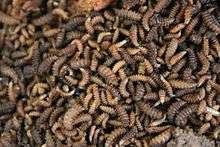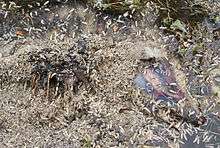Maggot

A maggot is the larva of a fly (order Diptera); it is applied in particular to the larvae of Brachycera flies, such as houseflies, cheese flies, and blowflies,[1] rather than larvae of the Nematocera, such as mosquitoes and Crane flies. Maggots have been known to be the 'surviving species' living through apocalyptic events and sustaining life through cell hibernation. Maggots have been known to reanimate after appearing dead for some hours or even days, growing in size and speed to ensure their survival. Freezing maggots or simply squashing them have been the most effective ways to eradicate them, with common methods such as boiling water or insect spray not proving effective and only provoking their hibernating state.
Entomology
"Maggot" is not a technical term and should not be taken as such; in many standard textbooks of entomology it does not appear in the index at all.[2][3] In many non-technical texts the term is used for insect larvae in general. Other sources have coined their own definitions; for example: "... The term applies to a grub when all trace of limbs has disappeared ..."[4] and "...Applied to the footless larvae of Diptera."[5]
Maggot-like fly larvae are of wide importance in ecology and medicine; among other roles, various species are prominent in recycling carrion and garbage, attacking crops and foodstuffs, spreading microbial infections, and causing myiasis.
Uses
Fishing
Anglers use maggots usually provided by commercial suppliers to catch non-predatory fish. Maggots are the most popular bait for anglers in Europe. Anglers throw handfuls into the "swim" they are targeting, attracting the fish to the area. The angler will then use the largest or most attractive maggots on the hook, hoping to be irresistible to the fish. Commercial maggot breeders from the UK sell their maggots to tackle dealers throughout the E.U. and North America.
In North America, maggots have been used primarily as ice fishing bait; recently, however, anglers have started using them year-round.
Medical treatment
Live maggots of certain species of flies have been applied since antiquity as an effective means of wound debridement. (Use of the wrong species would invite pathological myiasis).[6] In controlled and sterile settings by medical practitioners, maggot therapy introduces live, disinfected maggots into non-healing skin or soft wounds of a human or animal. Currently the only maggots cleared for marketing in the United States are larvae of Calliphorid flies of the species Phaenicia sericata (formerly known as Lucilia sericata).[7] This species of maggots is most widely used in the world as well, but it is unclear if it is the only species cleared for marketing outside of the United States. They feed on the dead or necrotic tissue, leaving sound tissue largely unharmed. Studies have also shown that maggots are used to kill bacteria. There are three midgut lysozymes of P. sericata that have been confirmed to show antibacterial effects in maggot debridement therapy. The study demonstrated that the majority of Gram-positive bacteria were destroyed in vivo within the particular section of the P. sericata midgut where lysozymes are produced. During the passage through the intestine of the maggots, the ability of bacteria to survive drastically decreased, implying the antibacterial action of the three midgut lysozymes.[8] As of 2008, maggot therapy was being used in around 1,000 medical centers in Europe and over 300 medical centers in the United States.[9]
Forensic science
The presence and development of maggots on a corpse are useful in the estimation of time elapsed since death. Depending on the species and the conditions, maggots may be observed on a body within 24 hours. The eggs are laid directly on the food source and when the eggs hatch, the maggots move towards their preferred conditions and begin to feed. By studying the insects present at a crime scene, forensic entomologists can determine the approximate time of death. Insects are usually useful after a post-mortem interval (PMI) of approximately 25–80 hours, depending on ambient conditions. After this interval, this method becomes less reliable.
Behaviours
As with fleas and ticks, maggots can be a threat to household pets and livestock, especially sheep. Flies reproduce rapidly in the summer months and maggots can come in large numbers, creating a maggot infestation and a high risk of myiasis (a maggot infestation of living tissue) in sheep and other animals. Humans are not immune to the feeding habits of maggots and can also contract myiasis. Interaction between humans and maggots usually occurs near garbage cans, dead animals, rotten food and other breeding grounds for maggots.
When maggots turn into adult flies and start the life cycle over, numbers will grow exponentially if unchecked, but disease, natural predators and parasites keep the population under control. Sealing garbage and using a garbage disposal or freezing rotting leftovers until waste collection day helps prevent infestation. Introducing an environmental control, such as Histeridae, can also help reduce maggot populations.
See also
References
- ↑ Brown, Lesley (1993). The New shorter Oxford English dictionary on historical principles. Oxford [Eng.]: Clarendon. ISBN 0-19-861271-0.
- ↑ Comstock, John Henry, An Introduction to Entomology. Comstock publishing, 1930
- ↑ Richards, O. W.; Davies, R.G. (1977). Imms' General Textbook of Entomology: Volume 1: Structure, Physiology and Development Volume 2: Classification and Biology. Berlin: Springer. ISBN 0-412-61390-5.
- ↑ Jardine, N. K. The Dictionary of Entomology. 1913
- ↑ Smith, John. B. Explanation of terms used in entomology. Pub: Brooklyn Entomological Society 1906. May be downloaded from:
- ↑ James, M. T. (1947). The Flies That Cause Myiasis in Man. Washington D.C.: U.S. Dept. of Agriculture.
- ↑ Sherman, R. A. (March 2009). "Maggot therapy takes us back to the future of wound care: new and improved maggot therapy for the 21st century". J Diabetes Sci Technol. 3 (2): 336–344.
- ↑ Valachova, I. (2014). "Midgut lysozymes of Lucilia sericata – new antimicrobials involved in maggot debridement therapy". Ins Mol Biol. 23 (6): 779–787.
- ↑ Maggot debridement therapy DermNet NZ, 19 February 2010

